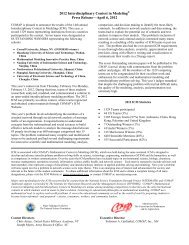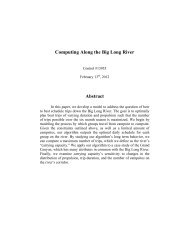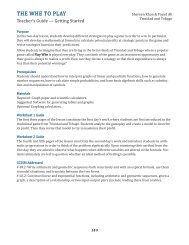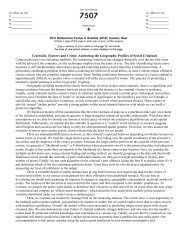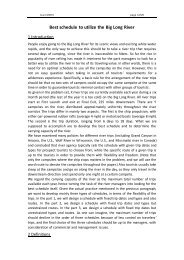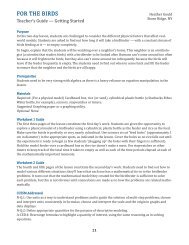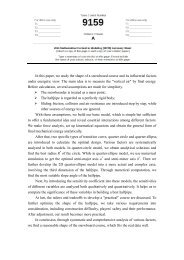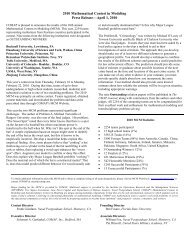You also want an ePaper? Increase the reach of your titles
YUMPU automatically turns print PDFs into web optimized ePapers that Google loves.
5. Could similar situations develop in other places in the oceans? What should we monitor and how?<br />
What is happening in the North Atlantic Gyre and the Alaskan Gyre? Use your model to estimate<br />
the plastic density in the future in the southern gyres (South Atlantic, South <strong>Pacific</strong>)?<br />
6. What is the immediate impact of banning polystyrene takeout containers? (See:<br />
http://bit.ly/5koJHB) What is the impact over 10–50 years?<br />
7. Any other scientific/technological issue associated with this situation is also acceptable, as long as<br />
modeling is an important component of your investigation and analysis.<br />
To clarify your task, focus on one critical aspect of this problem and model the behavior of the important<br />
matters or phenomena. Specify the quantities that are of greatest present or future interest to the one<br />
aspect you choose to model and analyze. Your ICM report should be in the form of a ten-page team<br />
report to an expedition leader who has asked you to help her identify the relevant behaviors of the matters<br />
and phenomena under consideration, provide the analysis for impact of the behavior of those matters or<br />
phenomena, and advise her on the government’s potential to act on the problem to improve this situation<br />
before it worsens.<br />
<strong>The</strong> following files contain some helpful data:<br />
CountDensity1999‐2009.pdf; Moore 2001.pdf; Yamashita 2007.pdf<br />
Here are some suggested papers you can use to inform your model formulation and obtain more<br />
data:<br />
Note: As a reminder, it is best to stick to the scientific literature, not the media coverage, for your facts.<br />
<strong>The</strong> mainstream media coverage of this issue has been misleading in many cases. For further explanation,<br />
see: http://seaplexscience.com/2009/11/13/millions-billions-trillions-of-scientific-errors-in-the-nyt/<br />
Committee on the Effectiveness of International and National Measures to Prevent and Reduce Marine<br />
Debris and Its Impacts (National Research Council). (2009). Tackling Marine Debris in the 21st<br />
Century, National Academies Press, Washington D.C.<br />
Dameron, O.J., Parke, M., Albins M.A., and Brainard R. (2007). Marine debris accumulation in the<br />
Northwestern Hawaiian Islands: An examination of rates and processes. Marine Pollution Bulletin,<br />
54:423–433.<br />
Derraik, J.G.B. (2002). <strong>The</strong> pollution of the marine environment by plastic debris: a review. Marine<br />
Pollution Bulletin, 44:842–852.<br />
Matsumura, S., and Nasu, K. (1997). Distribution of floating debris in the north <strong>Pacific</strong> <strong>Ocean</strong>: sighting<br />
surveys 1986–1991. In: Coe, J. and Rogers, D. (eds.). Marine Debris: Sources, Impacts and Solutions.<br />
Springer, New York, pp. 15–24.<br />
Moore, C.J., Moore, S.L., Leecaster, M.K., and Weisberg, S.B. (2001). A comparison of plastic and<br />
plankton in the North <strong>Pacific</strong> central gyre. Marine Pollution Bulletin, 42:1297–1300.<br />
Pichel, W.G., Churnside, J.H., Veenstra, T.S., Foley, D.G., Friedman, K.S., Brainard, R.E., Nicoll, J.B.,<br />
Zheng, Q., and Clemente-Colon, P. (2007). Marine debris collects within the North <strong>Pacific</strong> Subtropical<br />
Convergence Zone. Marine Pollution Bulletin, 54:1207–1211.







